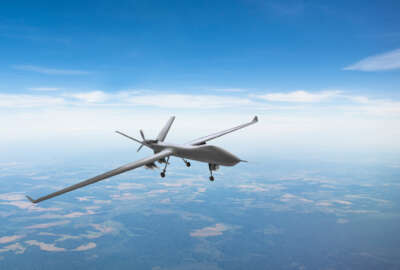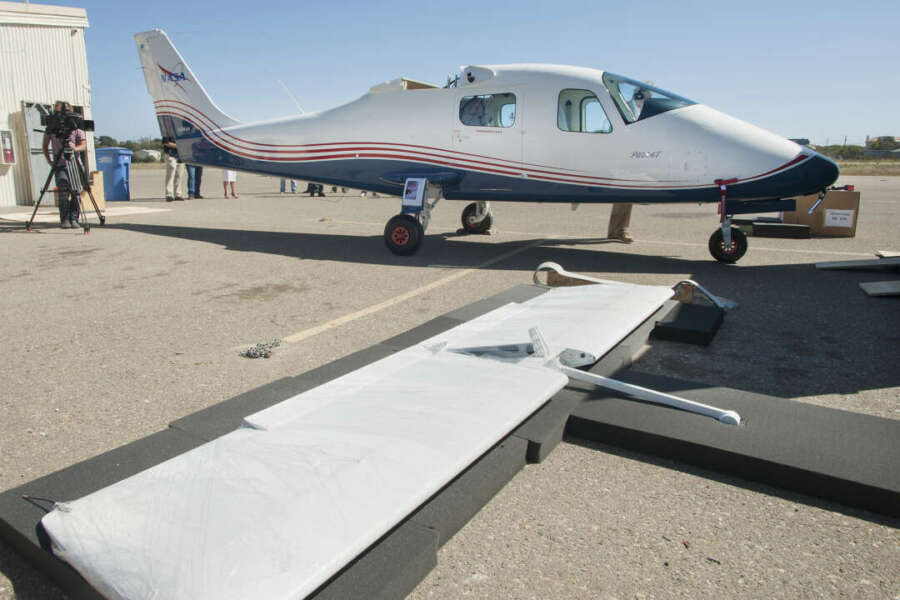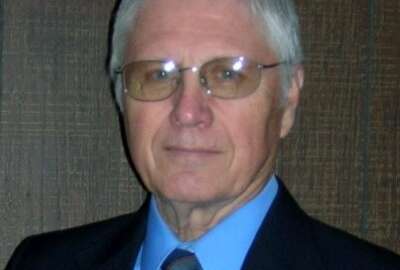
NASA explores the future of an airspace filled with flying taxis
Aviation is changing thanks to the emergence of new types of manned and unmanned aircraft. NASA's Advanced Air Mobility Mission seeks, in its words, to help eme...
Aviation is changing thanks to the emergence of new types of manned and unmanned aircraft. NASA’s Advanced Air Mobility Mission seeks, in its words, to help emerging aviation markets operate safely. The program pulls in many public and private partners. Joining the Federal Drive with a flyover view, NASA research and test pilot Gerrit Everson.
Interview transcript:
Tom Temin Tell us about the Advanced Air Mobility Mission. What precisely is NASA doing here?
Gerrit Everson Yeah, so we’re working with industry and teams of NASA researchers to advance the state of advanced air mobility. So specifically, I’m the partner demo team technical lead within our national campaign. And I oversee a variety of tactical teams, each working with a different industry partner, to advance certain subject areas that are very important to the state of advanced air mobility overall. So that’s one component. And I have a counterpart that works on a program called the Integration of Automated Systems. And that is working with our teams of NASA researchers and other federal partners to develop the automation algorithms that will use to provide high autonomy for these vehicles to navigate the highways and byways of the national airspace system. So that’s largely what we do under the national campaign. So and the portfolio of teams that I work with, we work with one partner that’s developing, UAM, Urban Air Mobility representative approaches to build those, because they’re quite a bit different than the traditional or legacy approaches that Southwest 737 would fly into Reagan National. To build those, evaluate those and measure their performance across a variety of performance parameters. We have another part team that’s working on detecting a void that’s making sure that highly autonomous vehicles can navigate the highways and byways of the national airspace, and provide strategic and tactical conflict avoidance with other airborne aircraft that happen to be out there. Whether these are eventually unmanned and there’s a lot of autonomy, we need to provide collision avoidance.
Tom Temin That whole idea of autonomy, that’s an important distinction to make from remotely piloted, because it could be that if it’s done right, autonomous would be even safer than remote piloting.
Gerrit Everson It can be. The goal is to have them highly automated. And some of our partners have a vision where there’s no pilot involved, and there would be a individual monitoring from a console and a remote station, but not so much piloting, the aircraft is making decisions on its own. And that is long range type things. And then there’s other aircraft that are highly automated with different control schemes and collision avoidance packages to help reduce the amount of training required and improve safety. So that’s a major component of what we do. Autonomy is definitely a focus area across within our industry and government partners and certainly with NASA. In fact, that’s a major component of the integration of automated systems team.
Tom Temin And is one of the challenges, the fact that what is considered under the advanced air mobility, these delivery packages or air taxis and this kind of thing, are an order of magnitude slower than, say, commercial jets. And then you’ve got general aviation, which is sort of in-between speed wise and the differential and speed and capability. Is that one of the challenges here?
Gerrit Everson Definitely, it’s one of the challenges. So that’s definitely a niche market to provide passenger transportation or package delivery from rural areas into urban environments or underserved markets into markets that have typical aircraft. So these aircraft, as you noted, fly slower and they also fly at a lower altitude. Plus the vision is to have them highly automated. So how do you develop the infrastructure and whether it’s bird ports, different routes through the national airspace to allow these aircraft go from point A to point B in a highly autonomous aircraft and have them be interoperable with the other aircraft that are out there? And one important point, is the state of energy density of the batteries. These aircraft don’t have the ability to loiter for 45 minutes should Reagan National have a ground delay for whatever reason. So we need to make sure they can all get from point A to point B safely, go to an alternate and measure the demand capacity from all the different places in a well orchestrated sort of way. So I think if the vision were all works out, by the end of the decade, it would be a well-choreographed system that works seamlessly. So long ways off for that, but that’s what our goal is. To work with industry partners and other government partners to develop that whole ecosystem and make it all work out.
Tom Temin Because the vision of personal mobility and flying cars and helmets with helicopters on them and this and that and the other, bubbles. That Jetson type of idea goes back 60, 75 years. What is the basis for thinking that now it’s a reality?
Gerrit Everson I think, we can make the electric aircraft a distributed propulsion systems similar to what you see on The Jetsons, that’s the analogy everyone likes to use, but it’s developing the ecosystem. So that’s what we’re looking at. We’re not looking at just the vehicle and just the electric motors. Some NASA programs are focused on that particular area, but we’re kind of looking at the ecosystem as a whole. And that is what hasn’t traditionally existed and the technology hasn’t been available. But we’re now starting to see that technology become available, whether it’s the batteries, whether it’s the collision avoidance sensor packages and all of the [Federal Aviation Administration (FAA)] surveillance radars that play into this whole system. There’s a ton of moving parts. And we had some pretty detailed conversations with all of our partners to build that ecosystem, pull it all together in a sort of way that we can make The Jetsons become a reality.
Tom Temin We’re speaking with Gerrit Everson. He’s a partner demonstration lead for NASA’s Advanced Air Mobility Mission National Campaign. He’s also a research and test pilot and experienced flier yourself. And tell us about the programmatic aspects of this. Who are some of the federal partners in the Air Mobility Mission?
Gerrit Everson Absolutely. So a big one is the FAA. Their task to oversee the certification of these new aircraft. The criteria to certify them don’t quite exist, so that’s under their portfolio. But we are here to work with the FAA to do unique testing and leverage each other’s processes to really advance the state of the industry. So the FAA is one of them. We also work with the Department of Transportation, they have unique test set ups and test ranges that we leverage and take advantage of. And then another big one is the Department of Defense. We have a great relationship with certain DoD organizations. One is, Agility Prime with the Air Force, where we’re leveraging each other’s test programs and test campaigns, in a synergistic sort of way, to achieve similar goals. Now, they are looking at [Electric vertical take-off landing (eVTOL) type aircraft in AAM from a mil use case perspective. And we’re looking at it from a civil use case perspective. So they’re very eager to see if we can use these aircraft, they’re extremely quiet. We got a small team of special ops personnel from point A to point B into an area and then out of an area seamlessly. And that clearly has overlapping objectives with the civil use case, just going from point A to point B. So combining our research programs reduces the cost to the taxpayer, and really, we think will allow us to advance the state of the industry so much quicker. So in fact, we’re slated to do some interesting testing with the Air Force at Edwards Air Force Base starting this fall, unmanned and then maybe even going manned. So we have some very exciting times ahead working with these strategic government partners.
Tom Temin And on the industry side, I’m imagining that there is almost like the equivalent of what’s happening in electric cars. There is this burgeoning industry of startups trying to get into this.
Gerrit Everson Absolutely. And yeah many in Silicon Valley, a ton of really brilliant people. That’s one of the aspects that I love about this job, is working with so many smart people that are just advancing this technology rapidly so fast that on the regulatory side, it can be hard to keep up. That’s why we’re partnering with DoD and the FAA, and having our best experts come in and say, how do we make this become a reality? But yeah, definitely emerging technologies in terms of the sensor packages, the batteries, the automation systems to make these aircraft fly seamlessly in an almost autonomous sort of way. So very cool stuff.
Tom Temin And the nation looks at autonomy for ground vehicles, and that’s not going that well actually, it’s much slower and much more complex than people even the proponents envisioned. What about the challenges for, really, software in aboveground in the air? Is that maybe closer to something we can understand and rely on? Say versus ground?
Gerrit Everson It’s a work in progress, absolutely. Yeah, that’s a great point. The software has to be certified, validated, verified and go through a very rigorous process that the automotive industry typically doesn’t do. It’s tremendously expensive and the stakes are so much higher in the air, obviously. So we want to make sure the software is well vetted and it meets certain design criteria. So how do you take the autonomous systems, neural nets and complex software? And that’s been designed properly and then verify it and validate it. That’s a that’s a very difficult path. We’re trying to wrap our arms around that right now, working with the FAA and industry, because that’s where the industry is going, and we want to make sure we can do that well, but maintain air safety standards for aviation. So that’s the goal and it’s kind of a work in progress.
Tom Temin And as a pilot yourself, and you have piloted the fastest and most advanced Navy fighters, as well as some slower types of planes and prop transports and so forth. What’s your take on that whole idea of unmanned autonomous flight? Does it make you worry?
Gerrit Everson It doesn’t make me worry. I think it’s a matter of getting the technology to the point where it works and it works seamlessly and we have the safety data to prove it. But also working with the public, in terms of community acceptance, making sure that this is safe and it’s well vetted and the public is comfortable with it. And community acceptance is actually a huge part of our program. But for me, that’s what I find fascinating is the tech that’s going to get us to that point. I know industry is tremendously interested in reducing the number of pilots, maybe dropping three pilots down to two, or even two down to one with a pilot in a remote station. So we’re not just going to suddenly go unmanned, boom, here we are, what do you think of this? It’s going to be a phased in approach. But as a pilot, I think that is the future and I really like the tech behind it. In fact, as you noted, I was a test pilot for the Navy flying F-14 and F-18. And my first job getting out, I worked for a large defense contractor as a test pilot on an unmanned program designed to land a unmanned aircraft on an aircraft carrier. And the Navy was very interested at the time to integrate unmanned aircraft in the carrier environment.
Tom Temin That’s happening even as we speak.
Gerrit Everson It is, yes. So this was a technology demonstrator that I worked on. But now, there’s other aircraft that they’re developing to be interoperable in the carrier environment, do shipboard landings and takeoffs and provide in-flight refueling and do other missions. So that’s becoming a reality. But that’s where the tech is going, and that’s what I find fascinating. So it doesn’t scare me, but I embrace it and want to see how we can do all of that to benefit the public.
Tom Temin And it strikes me that NASA’s Advanced Air Mobility Mission really doesn’t have an end point, because this could develop forever. Maybe it’ll become air mobility mission, because advanced will just be the routine. But I don’t see an end point to a program like this.
Gerrit Everson No, and that’s what’s very cool about it. It’s just, we see dates of the late 2020s, 2032 in our road map. So this isn’t something such as we’re just going to work with a contractor, build an electric vehicle and make it fly from point A to point B and we’re done. Developing that whole ecosystem is going to be a build up approach, with certain phases, to get to the point where you have this well choreographed ecosystem that works seamlessly. That’s years away. So just working with teams that are both brilliant people, whether it’s industry or other government agencies, is what I find fascinating. But yeah, it’s a rare opportunity to participate in such a program that’s going to do so much over a long period of time. Usually the spectrum, in terms of the schedule, is a lot smaller. Six months maybe, or a few years. In fact, in my prior life when I did science missions for NASA as the test pilot, we do a mission that will last a year or two, and then that was it. So this is much different. Working over a decade advanced the state of the industry.
Tom Temin So the day will come when the average American will have a pizza delivered by an autonomous vehicle, then step into one to fly to the airport.
Gerrit Everson That’s the vision, yep. Step into an autonomous vehicle to get to the airport. We have partners that are doing that right now, not on manned, they’re manned, but trying to provide passengers from different areas of Manhattan into the three surrounding airports at a reasonable cost. And that’s the major factors, how do we reduce the cost so that it’s no more than a taxi fare, Uber fare that you’re kind of used to today. So we’re not quite there yet. But that’s the vision.
Copyright © 2024 Federal News Network. All rights reserved. This website is not intended for users located within the European Economic Area.
Tom Temin is host of the Federal Drive and has been providing insight on federal technology and management issues for more than 30 years.
Follow @tteminWFED





